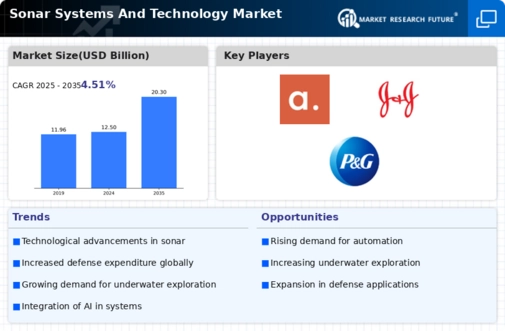Top Industry Leaders in the Sonar Systems Technology Market

Strategies Adopted:
Technological Innovation: Key players invest in research and development to innovate sonar technology, improving performance, sensitivity, resolution, and reliability to meet evolving customer requirements and market demands.
Product Differentiation: Companies differentiate their sonar systems by offering specialized features, functionalities, and performance metrics tailored to specific applications such as naval warfare, maritime surveillance, fisheries, and oil and gas exploration.
Strategic Partnerships: Collaboration with government agencies, defense contractors, research institutions, and industry stakeholders helps companies expand market reach, access new customers and markets, and leverage complementary capabilities and resources.
Market Diversification: Companies explore opportunities to diversify into adjacent markets such as underwater exploration, environmental monitoring, marine research, and offshore energy, leveraging their sonar technology expertise and capabilities.
Competitive Intensity Within The Industry
Raytheon Company (US)
Lockheed Martin Corporation (US)
Thales Group (France)
L3Harris Technologies, Inc (US)
Kongsberg Maritime (Norway)
Aselsan AŞ (Turkey)
Teledyne Technologies Incorporated (US)
Ultra Electronics (UK)
Wärtsilä (Finland)
FURUNO Electric Co., Ltd (Japan)
Sonardyne (UK)
Atlas Elektronik Group (Germany)
Navico (Norway),
Japan Radio Co. (Japan)
DSIT Solutions Ltd (Israel)
EdgeTech (US)
Factors for Market Share Analysis:
Technology Leadership: Market share analysis considers companies' technological expertise, innovation capabilities, and investment in sonar research and development, as well as their track record of delivering reliable and effective sonar solutions.
Product Portfolio and Customer Base: The breadth and depth of product portfolios, as well as the size and loyalty of customer bases, influence market share by demonstrating companies' ability to meet diverse customer needs and preferences.
Industry Reputation and Brand Recognition: Companies with strong reputations for reliability, performance, and customer support are more likely to gain market share and outperform competitors in the highly competitive sonar systems and technology market.
New and Emerging Companies:
L3Harris Technologies: L3Harris offers sonar solutions for defense and commercial markets, including underwater acoustic sensors, sonar signal processing systems, and underwater vehicle navigation systems.
Teledyne Technologies Incorporated: Teledyne provides sonar technology for marine and underwater applications, offering hydrophones, acoustic transducers, and underwater imaging systems for defense, research, and exploration.
Sonardyne International Ltd.: Sonardyne specializes in underwater acoustic positioning, navigation, and communication systems, offering solutions for offshore energy, marine research, and defense applications.
Industry News and Current Trends:
Autonomous Underwater Vehicles (AUVs): There is a growing trend towards the integration of sonar technology into autonomous underwater vehicles (AUVs) for underwater surveying, mapping, inspection, and surveillance applications.
Multifunctional Sonar Systems: Companies are developing multifunctional sonar systems that combine capabilities such as search and detection, classification and identification, tracking and localization, and communication and navigation in a single platform.
Environmental Monitoring and Protection: Sonar technology is increasingly used for environmental monitoring and protection, including habitat mapping, marine mammal detection, pollution monitoring, and ecosystem management.
Overall Competitive Scenario:
The sonar systems and technology market is characterized by intense competition among key players, driven by technological innovation, market demand, and regulatory considerations. Companies differentiate themselves through product innovation, performance differentiation, and customer relationships. New entrants and emerging companies disrupt the market with innovative technologies, partnerships, and business models tailored to specific market segments and customer needs. Collaboration, innovation, and customer-centricity are key drivers of success in the dynamic and competitive sonar systems and technology market.
Recent Market Development
Kongsberg To Provide Sonar And Navigation Systems For Type 212CD Submarines. Active sonar suite and bottom navigation technology from Kongsberg Maritime (KONGSBERG) has been selected for installation on Type 212CD class submarines for both the Norwegian and German navies.
According to the Taiwanese Naval Officials, IDS will be provided with MK-48 Mod 6 Advanced Technology heavyweight torpedoes, UGM-84L sub-launched Harpoon Block II missiles, and other combat and digital sonar systems provided by US suppliers Lockheed Martin and Raytheon.


